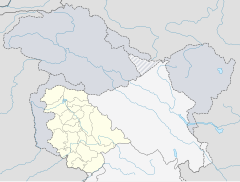Hazratbal Shrine
| Dargah Sharif | |
|---|---|
درگاہ شریف | |
 The Hazratbal Shrine in 2010 | |
| Religion | |
| Affiliation | Islam |
| District | Srinagar District |
| Region | Kashmir Valley |
| Leadership | Jammu and Kashmir Muslim Waqf Board |
| Status | Active |
| Location | |
| Location | Hazratbal |
| Municipality | Srinagar |
| Country | India |
 Location within Jammu and Kashmir | |
| Territory | Jammu and Kashmir |
| Geographic coordinates | 34°7′45″N 74°50′32″E / 34.12917°N 74.84222°ECoordinates: 34°7′45″N 74°50′32″E / 34.12917°N 74.84222°E |
| Architecture | |
| Type | Islamic architecture |
| Style | Classical |
| Specifications | |
| Length | 105 metres (344 ft) |
| Width | 25 metres (82 ft) |
| Dome(s) | 1 |
| Minaret(s) | 1 |
| Website | |
| http://www.wakf.gov.in/jammukashmir/ | |
The Hazratbal Shrine or Dargah Sharif is a Muslim shrine located in Hazratbal, Srinagar, Jammu and Kashmir, India. It contains a relic, the Moi-e-Muqqadas, which is widely believed to be the hair of the main Islamic prophet, Muhammad.[1] The name of the shrine is a combination of the Persian word Hazrat (lit. 'respected') and the Kashmiri word bal (lit. 'place').
The shrine is situated on the northern bank of the Dal Lake in Srinagar, and is considered to be Kashmir's holiest Muslim shrine.[2]
History and present status[]
The shrine contains strands of what is believed by many Muslims to be the hair of the Islamic prophet Muhammad. The relic was first brought to Kashmir by Syed Abdullah, a purported descendant of Muhammad who left Medina (in present-day Saudi Arabia) and settled in the South Indian city of Bijapur in 1635, at a time when the Islamic Mughal Empire was rapidly expanding across India.[1][2]
Following Abdullah's death, his son Syed Hamid inherited the relic. The region was conquered by the Mughals shortly afterwards, and Hamid was stripped of his family estates. Finding himself unable to care for the relic, he sold it to Khwaja Nur-ud-Din Eshai, a wealthy Kashmiri businessman.[citation needed]
However, when the Mughal emperor Aurangzeb was informed of the holy relic's existence and transfer, he had it seized and sent to the shrine of Sufi mystic Mu'in al-Din Chishti in Ajmer, and imprisoned Eshai in Delhi. Later, Aurangzeb decided to return the relic to Eshai and allow him to take it to Kashmir. However, Eshai had already died while imprisoned. By 1700, the relic had been transported to Kashmir, along with the body of Eshai. There, Inayat Begum, the daughter of Eshai, became the custodian of the relic and established the Hazratbal Shrine. Since then, her male descendants have been caretakers of the relic at the mosque.[3]


Begum's male descendants belong to what is known as the Banday family. As of 2019, three main members care for the holy relic: Manzoor Ahmad Banday, Ishaq Banday and Mohiuddin Banday.[citation needed] The relic is displayed for public view only on special Islamic occasions, such as the birthdays of Muhammad and his 4 main companions (Abu Bakr, Umar, Usman and Ali).
The caretakers of the shrine are known as Nishandehs. The eldest male heirs of the previous Nishandeh continue the legacy of displaying the relic when their predecessor dies.
1963 Moi-e-Muqqadas disappearance episode[]
The Moi-e-Muqqadas, a relic widely believed by Muslims to be the hair of the Islamic prophet Muhammad, was reported to have gone missing from the shrine on 27 December 1963. Following its disappearance, mass demonstrations were held all over the state, with hundreds of thousands of protesters out in the streets.[citation needed] On 31 December, Indian Prime Minister Jawaharlal Nehru made a broadcast to the nation on the disappearance of the sacred Muslim relic, and sent a team from the Central Bureau of Investigation into Jammu and Kashmir to probe the suspected theft.[4]
The incident led to communal tensions and riots in the Indian state of West Bengal and East Pakistan (now Bangladesh), due to which India saw a refugee influx of around 200,000 people between December 1963 and February 1964.[5]
The relic was recovered by Indian authorities on 4 January 1964.[3][6][7]
See also[]
| Wikimedia Commons has media related to Hazratbal shrine. |
References[]
- ^ "Moslems Riot Over Theft of Sacred Relic", Chicago Tribune, 29 December 1963, p1
- ^ "Kashmir Yield at Shrine". New York Times. 7 August 1994. The shrine is known by many names including Hazratbal, Assar-e-Sharief, Madinat-us-Sani, or simply Dargah Sharif.
- ^ Jump up to: a b Hari Narain Verma; Amrit Verma (1998). Decisive battles of India through the ages, Volume II. GIP Books. p. 124. ISBN 978-1-881155-04-1. Retrieved 22 June 2010.
- ^ "Hanging By The Relic". Kashmir Life. Retrieved 23 January 2017.
- ^ Das, Mayurakshi. "Title: Calcutta Cauldron: City-life during the January 1964 Riots". Indian History Congress Proceedings.
- ^ Neelam Francesca; Rashmi Srivastava (2008). Secularism in the postcolonial Indian novel: national and cosmopolitan narratives in English. Volume 17 of Routledge research in postcolonial literatures. Routledge. p. 70. ISBN 978-0-415-40295-8. Retrieved 22 June 2010.
- ^ "Forgotten probes". Greater Kashmir. Retrieved 23 January 2017.
- Sufi shrines in India
- Buildings and structures in Srinagar
- Mosques in Jammu and Kashmir



